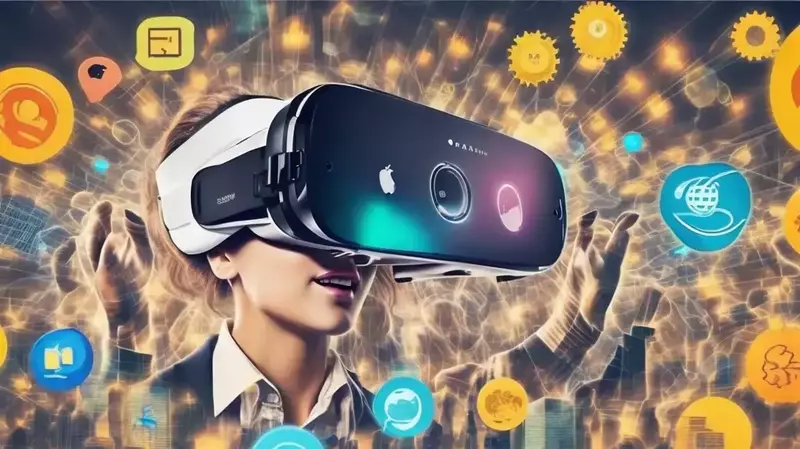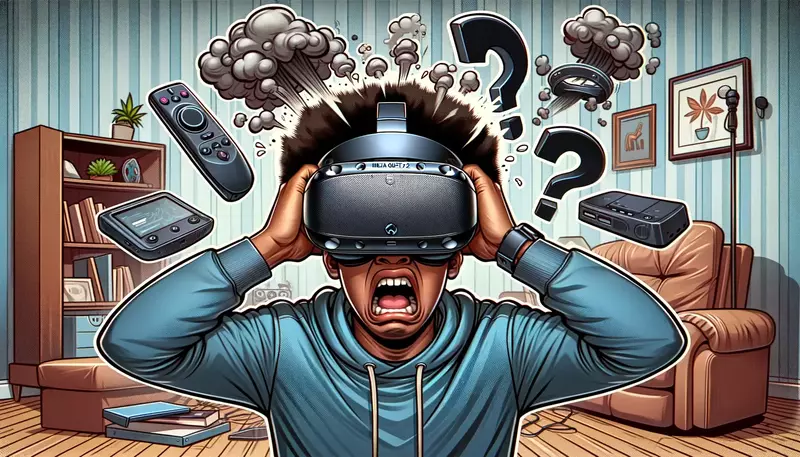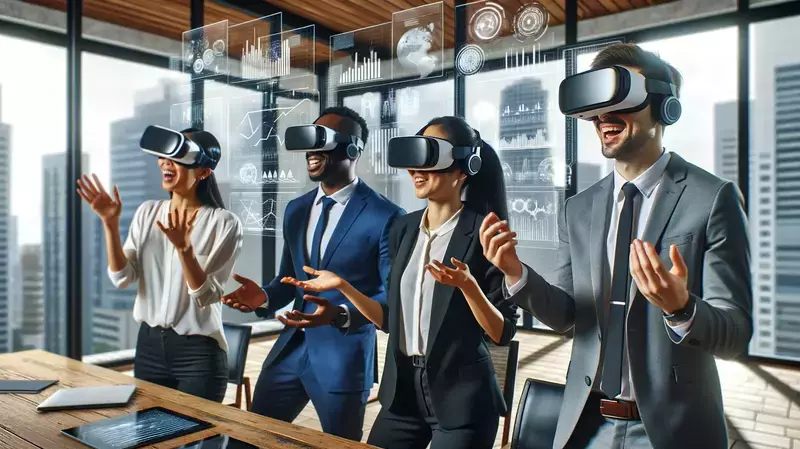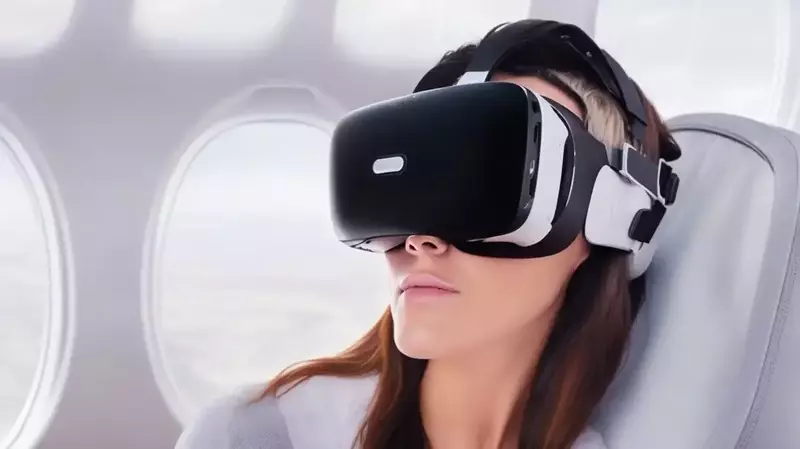This site contains affiliate links to products, and we may receive a commission for purchases made through these links.
What opportunities does virtual reality provide in digital marketing? As the world of technology continues to evolve, marketers are constantly seeking innovative ways to engage with their target audience.
In this blog post, we will explore how leveraging virtual reality for digital marketing can help brands craft engaging content and enhance brand awareness.

Key Takeaways:
- VR in digital marketing allows for the creation of engaging and immersive content that appeals to customers’ emotions and senses.
- VR can be leveraged for immersive product demonstrations, virtual tours and experiences, gamification, and interactive content, and enhanced social media integration.
- By using VR, brands can enhance brand awareness, reach new audiences, create memorable experiences, and showcase their innovation and creativity.
- Measuring the impact of VR on digital marketing involves tracking user engagement metrics, evaluating conversion rates, A/B testing VR experiences, and surveying customer satisfaction.
- Integrating VR into existing digital strategies involves identifying opportunities for integration, creating engaging virtual experiences, promoting VR content effectively, and measuring success to adjust strategies accordingly.
Leveraging Virtual Reality for Digital Marketing
VR has advanced significantly in recent years, and marketers can take advantage of its potential to revolutionize digital marketing by creating engaging content that appeals to customers’ emotions and senses.
Forbes highlights the importance of leveraging VR in digital marketing strategies, as it allows marketers to create interactive content that appeals to users’ emotions and senses, resulting in memorable experiences that leave lasting impressions on consumers.
Immersive Product Demonstrations
Virtual reality can showcase products or services more effectively than traditional methods, such as IKEA’s VR showroom, which enables customers to explore fully furnished rooms and customize furniture arrangements without leaving their homes.
Virtual Tours & Experiences
Real estate companies can provide potential buyers with virtual walkthroughs of properties, while travel agencies might offer 360-degree previews of vacation destinations – all from the comfort of one’s own home.
Gamification & Interactive Content
Businesses can utilize gaming elements in their digital campaigns to generate engaging, interactive experiences that prompt customers to form a stronger connection with the brand.
Enhanced Social Media Integration
Social media platforms are beginning to embrace virtual reality, providing new opportunities for brands to connect with their audiences, such as Facebook’s Spaces app that allows users to interact in VR environments while sharing content with friends.
In summary, virtual reality in digital marketing provides vast and varied opportunities for businesses to create immersive experiences that resonate with customers and drive sales like never before.
“Revolutionize your digital marketing strategy with virtual reality. Create immersive experiences that engage customers on a deeper level and drive sales. #VRMarketing #DigitalTransformation”Click to Tweet
Crafting Engaging Content with VR
Content creation with VR provides a unique chance to construct captivating experiences that touch customers in a more meaningful way.
Interactive storytelling experiences allow users to actively participate in the story, making them feel more connected to your brand and message.
- 360-degree videos give viewers an all-encompassing perspective of their surroundings.
- VR can be used for educational experiences, providing hands-on tutorials or simulations within the virtual environment.
- Gamification adds an extra layer of engagement while promoting friendly competition among users.
Consider technical aspects and user experience design principles during development to ensure high-quality graphics, smooth performance, intuitive navigation, and clear calls-to-action.
Distribute your VR content on platforms like YouTube and Facebook to reach a wider audience.
By leveraging the power of VR, you can create memorable content that resonates with customers on a deeper level than traditional formats alone.
“Revolutionize your digital marketing game with Virtual Reality. Engage customers on a deeper level through immersive experiences and interactive storytelling. #VRMarketing #DigitalMarketingTips “Click to Tweet
Enhancing Brand Awareness with VR
VR provides a special chance for companies to make immersive experiences that stay in the minds of their intended viewers.
By incorporating VR into your digital marketing strategy, you can enhance brand awareness and reach new audiences in innovative ways.
Creating Memorable Experiences
VR transports users into fully realized 3D environments where they can interact with your brand’s products or services in an engaging manner.
TOMS Shoes used VR technology to give customers a firsthand look at the impact their purchases have on communities around the world, creating an emotional connection between consumers and the brand.
Expanding Your Reach Through Social Media Integration
Social media sharing options within your VR experiences allow users to easily share their experience with friends and followers online, increasing your brand’s visibility.
Platforms like Facebook Spaces even allow users to interact in virtual spaces together, opening up new possibilities for collaborative engagement with your content.
Catering To Gamers And Explorers Alike
- Gamification: VR provides ample opportunities for gamification by allowing brands to create interactive games or challenges related to their products or services that engage both gamers and non-gamers alike.
- Educational Content: Brands can also use VR as a tool for educating consumers about their products, services, or even the industry as a whole.
- For example, National Geographic created a VR experience that allowed users to explore Mars and learn about space exploration.
Showcasing Your Brand’s Innovation And Creativity
By embracing VR technology in your digital marketing efforts, you can demonstrate your brand’s commitment to innovation and creativity.
Utilizing VR can set your brand apart from the competition and draw in tech enthusiasts who seek out cutting-edge experiences.
Incorporating VR into your digital marketing strategy offers numerous opportunities for enhancing brand awareness and reaching new audiences.
By creating memorable experiences through immersive content, integrating social media sharing options, catering to gamers and explorers alike with gamification and educational content, and showcasing your brand’s innovative spirit, you can leverage the power of VR to make lasting impressions on potential customers.
Key Takeaway:
Virtual reality (VR) provides unique opportunities for brands to enhance brand awareness and reach new audiences through immersive experiences. By incorporating VR into digital marketing strategies, brands can create memorable experiences, expand their reach through social media integration, cater to gamers and explorers alike with gamification and educational content, and showcase their innovative spirit. This allows them to differentiate themselves from competitors while attracting tech-savvy consumers interested in cutting-edge experiences.
Measuring the Impact of VR on Digital Marketing
To accurately assess the effectiveness of your VR campaigns, it is important to measure user engagement metrics such as dwell time, interaction rate, and social shares.
Analyzing User Engagement Metrics
Track user engagement metrics like dwell time, interaction rate, and social shares to gauge the success of your VR campaign.
Evaluating Conversion Rates
Keep track of conversion rates before and after implementing VR initiatives to see if they’re contributing to an increase in sales or leads generated from online channels.
A/B Testing Virtual Reality Experiences
- Create multiple versions: Run A/B tests to compare different variations of a single experience.
- Gather feedback: Encourage users to provide feedback on their preferences and experiences.
- Analyze results: Use data-driven insights to determine which version performs better and make informed decisions for future campaigns.
Surveying Customer Satisfaction
Conduct customer satisfaction surveys to gain valuable insights into what aspects of your VR content resonate the most with your target audience.
By measuring the impact of your VR initiatives using these methods, you can maximize ROI and ensure continued success in this rapidly evolving space.
“Unlock the full potential of virtual reality in digital marketing with these proven methods for measuring impact and maximizing ROI. #VRMarketing #DigitalMarketing”Click to Tweet
Integrating VR into Existing Digital Strategies
Maximizing the effect of VR in digital marketing plans is essential for companies to remain competitive.
Identifying Opportunities for VR Integration
Pinpoint areas where VR can make the most significant impact, such as product demos, training sessions, or virtual tours.
Creating Engaging Virtual Experiences
Develop custom-built VR applications or experiences, collaborate with experienced developers or designers, and engage users with fun, immersive games.
- Product Demonstrations: Showcase products in a realistic environment where potential customers can virtually “try before they buy.”
- Educational Content: Offer informative tutorials and walkthroughs using interactive elements within the virtual space.
- Gamification: Engage users with fun, immersive games that incorporate your brand’s products or services.
Promoting Your VR Content
Promote VR content effectively within existing digital marketing channels, share teasers and previews on social media platforms, incorporate VR content into email campaigns, and partner with influencers in the gaming and tech industries.
Influencers in the gaming and tech industries can help amplify your message and reach new audiences.
Measuring Success and Adjusting Strategies
Track the success of VR efforts by monitoring KPIs such as user engagement levels, conversion rates, and overall ROI. Analyze data regularly to identify areas for improvement and adjust strategies accordingly.
Integrating virtual reality into digital marketing strategies creates unique customer experiences that drive engagement and loyalty.
“Revolutionize your digital marketing strategy with virtual reality. Engage customers like never before and drive loyalty through immersive experiences. #VRMarketing #DigitalStrategy”Click to Tweet
FAQs in Relation to What Opportunities Does Virtual Reality Provides in Digital Marketing?
What are the benefits of virtual reality (VR) in digital marketing?
Virtual reality offers enhanced user engagement, improved conversion rates, personalized content delivery, and competitive differentiation.
In which industries can virtual reality revolutionize?
Virtual reality has the potential to revolutionize industries such as gaming, education, healthcare, and real estate.
What does the future hold for virtual reality in marketing?
The future of virtual reality in marketing includes greater adoption by businesses, integration with other technologies, expansion into new sectors, development of advanced analytics tools, and continued growth driven by technological advancements.
!! For more information about the different VR headsets on the market, check out this product specification list.
Final Thoughts
How Virtual Reality is Revolutionizing Digital Marketing
Virtual reality is changing the game for digital marketers, providing a unique and immersive experience that engages consumers like never before.
By incorporating VR into their campaigns, brands can create memorable experiences that leave a lasting impression on their audience.
From product demos to virtual tours, the possibilities for VR in marketing are endless, and businesses that embrace this technology are sure to stand out from the competition.
As VR continues to evolve, it’s important for marketers to stay up-to-date with the latest trends and techniques to ensure they’re getting the most out of this exciting new medium.
So if you’re looking to take your digital marketing to the next level, consider incorporating virtual reality into your strategy and see the results for yourself!

Espen
Espen is the Director of PursuitMeta and has written extensively about Virtual Reality and VR Headsets for years. He is a consumer product expert and has personally tested VR Headsets for the last decade.




Leave a Reply